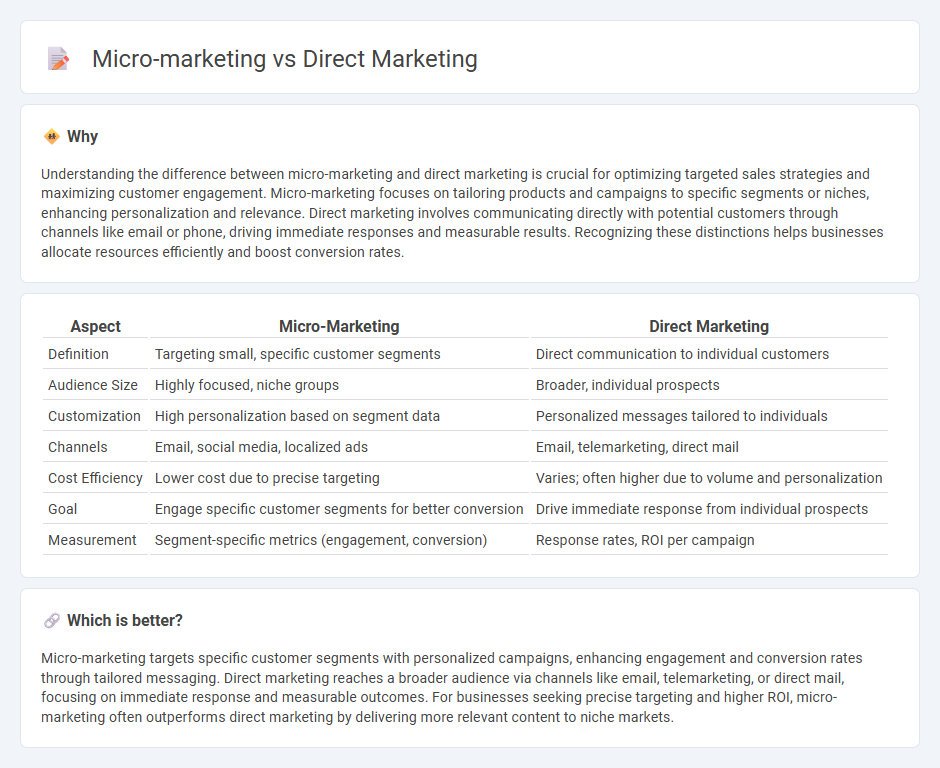
Micro-marketing targets narrowly defined customer segments with highly personalized campaigns, maximizing relevance and engagement at a local or individual level. Direct marketing involves communicating directly with potential customers through channels like email, telemarketing, or mail to generate immediate responses and measurable sales outcomes. Explore key strategies and benefits of each method to optimize your sales approach.
Why it is important
Understanding the difference between micro-marketing and direct marketing is crucial for optimizing targeted sales strategies and maximizing customer engagement. Micro-marketing focuses on tailoring products and campaigns to specific segments or niches, enhancing personalization and relevance. Direct marketing involves communicating directly with potential customers through channels like email or phone, driving immediate responses and measurable results. Recognizing these distinctions helps businesses allocate resources efficiently and boost conversion rates.
Comparison Table
| Aspect | Micro-Marketing | Direct Marketing |
|---|---|---|
| Definition | Targeting small, specific customer segments | Direct communication to individual customers |
| Audience Size | Highly focused, niche groups | Broader, individual prospects |
| Customization | High personalization based on segment data | Personalized messages tailored to individuals |
| Channels | Email, social media, localized ads | Email, telemarketing, direct mail |
| Cost Efficiency | Lower cost due to precise targeting | Varies; often higher due to volume and personalization |
| Goal | Engage specific customer segments for better conversion | Drive immediate response from individual prospects |
| Measurement | Segment-specific metrics (engagement, conversion) | Response rates, ROI per campaign |
Which is better?
Micro-marketing targets specific customer segments with personalized campaigns, enhancing engagement and conversion rates through tailored messaging. Direct marketing reaches a broader audience via channels like email, telemarketing, or direct mail, focusing on immediate response and measurable outcomes. For businesses seeking precise targeting and higher ROI, micro-marketing often outperforms direct marketing by delivering more relevant content to niche markets.
Connection
Micro-marketing targets highly specific customer segments to tailor promotional efforts, which enhances the effectiveness of direct marketing campaigns by delivering personalized messages. Direct marketing uses data-driven insights from micro-marketing strategies to engage potential buyers through channels like email, SMS, and social media, increasing conversion rates. The integration of micro-marketing analysis with direct marketing execution maximizes ROI by focusing resources on the most responsive audience segments.
Key Terms
**Direct Marketing:**
Direct marketing targets specific customer segments through personalized communication channels like email, SMS, and direct mail, aiming to generate immediate responses and measurable results. It leverages data analytics and customer insights to tailor messages for higher engagement and conversion rates. Discover how direct marketing strategies can enhance your customer reach and ROI by exploring our comprehensive guide.
Target Audience
Direct marketing targets specific customer segments with personalized messages to drive immediate responses, often using channels like email, SMS, and direct mail. Micro-marketing narrows this focus further by tailoring campaigns to highly specific, smaller audience subsets based on detailed demographics or behaviors, maximizing relevance and engagement. Explore strategies to effectively reach and convert your ideal customers through targeted marketing approaches.
Call to Action
Direct marketing emphasizes broad, targeted calls to action designed to generate immediate consumer response through channels like email, telemarketing, and direct mail. Micro-marketing narrows the focus to highly personalized calls to action aimed at specific segments or individual customers, enhancing engagement and conversion rates. Explore how tailoring your call to action strategy can maximize marketing effectiveness.
Source and External Links
What Is Direct Marketing? Definition, Examples, and Guide - Shopify - Direct marketing delivers targeted advertising messages straight to individual potential customers using channels like email, social media, and direct mail to create personalized communication aimed at prompting specific actions such as purchases or inquiries.
What is Direct Marketing: Definition and Examples - Direct marketing is a campaign type focused on establishing a personal relationship between the customer and the marketing organization through direct communication without intermediaries and with a mechanism for customers to respond directly.
How To Build An Effective Direct Marketing Strategy - The CMO - Direct marketing strategies include targeted channels such as telemarketing, door-to-door sales, and direct-response marketing to engage customers personally and measure campaign effectiveness while optimizing resources.
 dowidth.com
dowidth.com